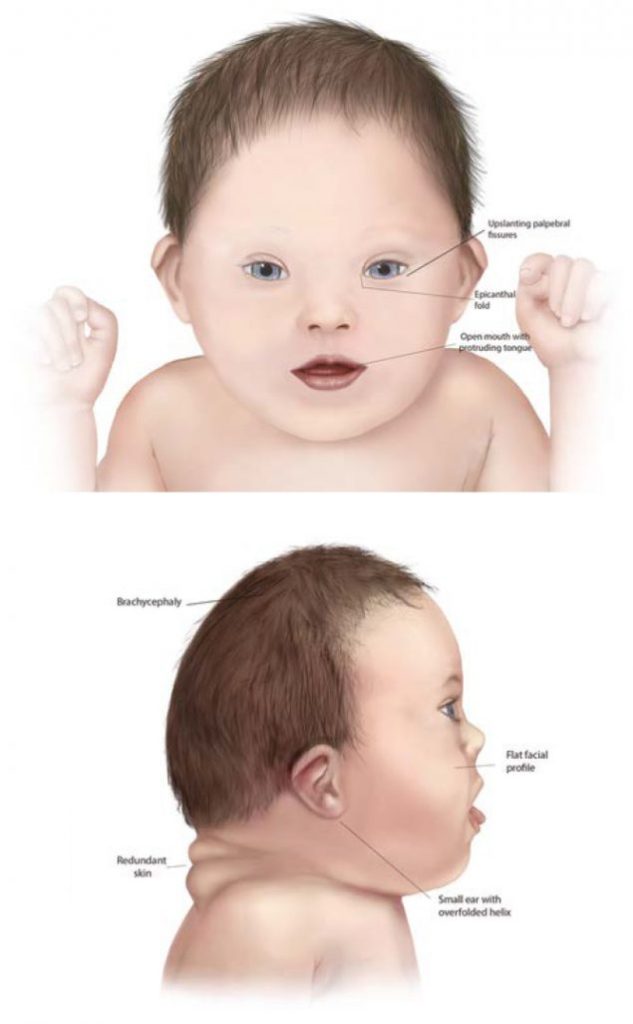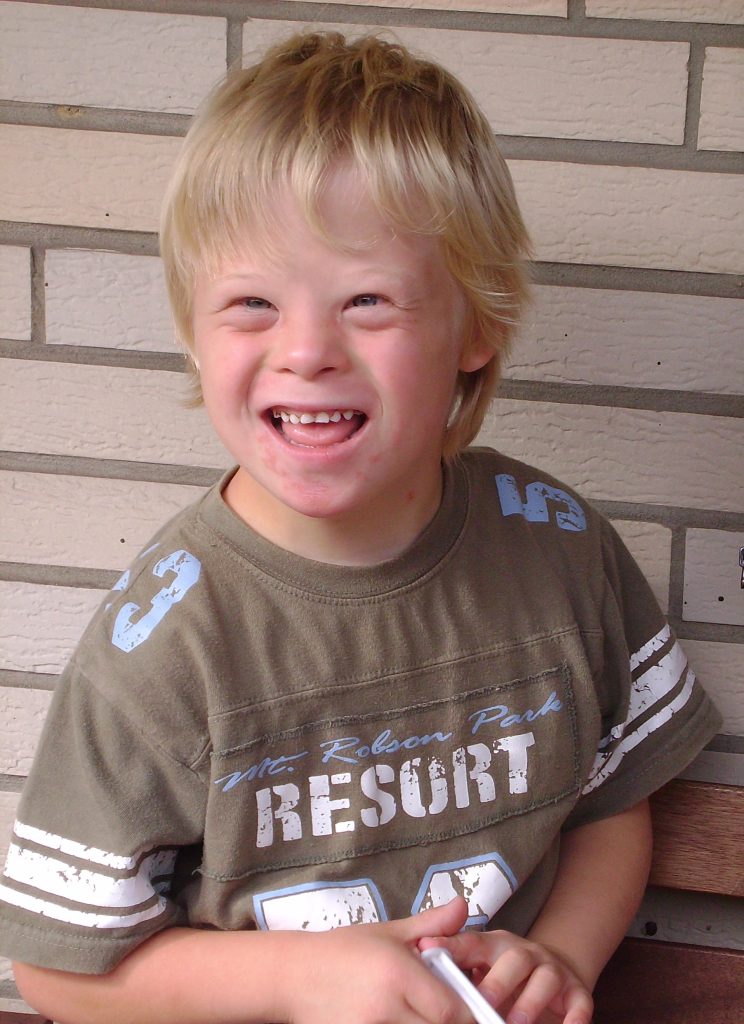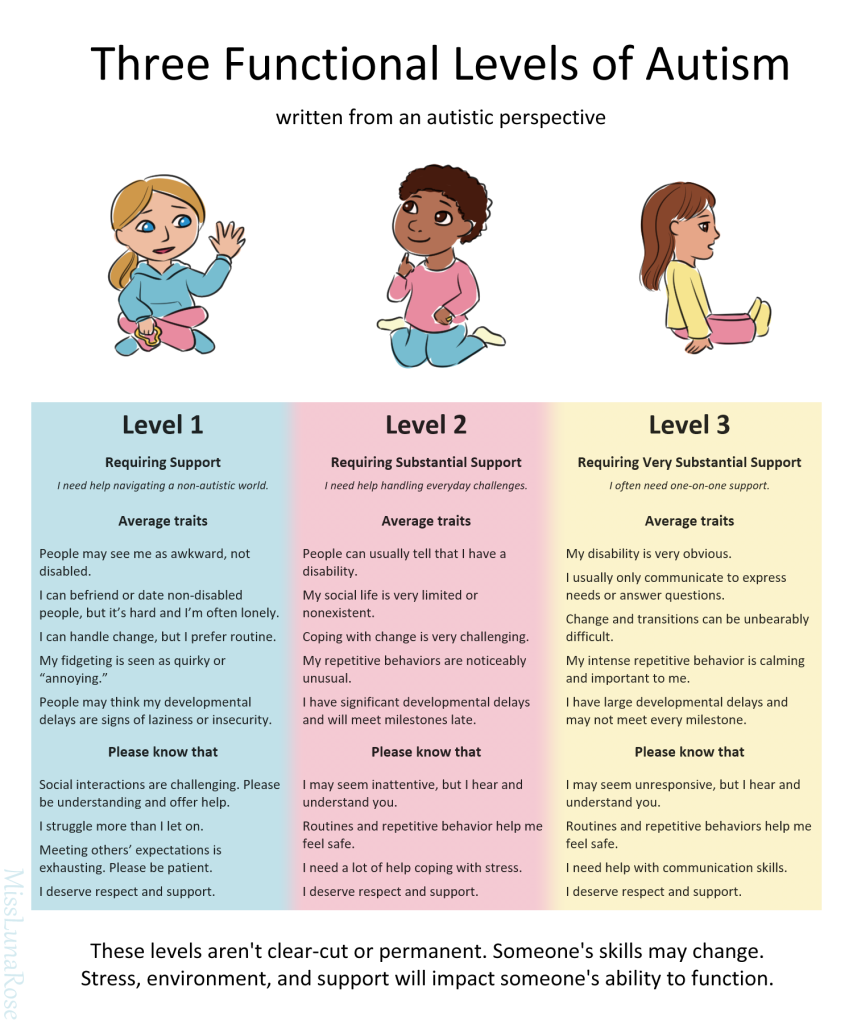Developmental disorders, also referred to as “intellectual disabilities,” are caused by impairments in the brain or central nervous system. These impairments result from problems that occurred during fetal development or injuries sustained during birth or early infancy, such as cerebral palsy and autism. Other disorders, such as Down syndrome, have a genetic cause.[1]
These impairments can impact mobility, problem-solving, planning, abstract thinking, judgment, academic learning, and learning from experience. Individuals with developmental disorders often function at a lower developmental stage than the average person of the same chronological age.[2]
Intellectual disabilities are diagnosed by health care providers based on two major criteria[3]:
- The ability to learn, think, solve problems, and make sense of the world, referred to as intellectual functioning or Intelligence Quotient (IQ).
- The skills and abilities to live independently, referred to as adaptive behavior or adaptive functioning.
Intellectual functioning is typically measured by a standardized IQ test. The average score of an IQ test is 100. People scoring below 70 to 75 are thought to have an intellectual disability.
To measure adaptive behavior, professionals look at what an individual can do in comparison to other individuals their age. Skills important for adaptive behavior include the following[4]:
- Daily living skills, such as getting dressed, going to the bathroom, and feeding oneself
- Communication skills, such as understanding what is said and being able to answer
- Social skills with peers, family members, adults, and others
Adaptive behavior is much more about how a person manages in daily life and their ability to do the things that are expected of their age within their culture. Without ongoing support, deficits in adaptive behavior limit an individual’s functioning in many areas such as communication, social participation, and independent living at home, school, work, or in the community. A person without adequate adaptive behaviors requires caregivers and other types of resources depending on their level of impairment. As a nursing assistant, you may be providing most of their needed support.
Levels of severity of intellectual disability and associated care needs can be categorized into mild, moderate, severe, and profound. It is important for nursing assistants to know what can be expected and how to care for individuals with these levels of disabilities[5]:
- Mild Intellectual Disabilities: In very young children with mild intellectual disabilities, there may be no obvious problems, but as they enter school, they often demonstrate difficulties in academic skills. As they become adults, abstract thinking and short-term memory are reduced, and communication is more immature than expected for their age. They may have difficulties regulating their emotions or have impaired social judgment, which puts them at risk of being manipulated by others. The individual may be independent with their activities of daily living (ADLs) and personal hygiene needs but requires support with shopping, cooking, housekeeping, and managing money. They may require assistance in finding appropriate leisure activities, as well as making health care decisions and legal decisions. Individuals with mild disabilities may be employed in jobs that don’t require much decision-making.[6]
- Moderate Intellectual Disabilities: The conceptual skills of individuals with moderate intellectual disability can be observed because they are behind in development compared to their peers. For school-aged children, their academic achievement is limited, and their learning progress is slow in all areas compared to their peers. As they become adults, their academic skills typically remain at a primary school level. They rely on spoken words for communication and are often unable to understand written instructions. They develop personal relationships, although they may not perceive or interpret social cues accurately. Social judgment and decision-making abilities are limited, and appointed caregivers must assist them with important life decisions. An individual with moderate intellectual disabilities can achieve most of their ADLs if given appropriate time, verbal cues, and supervision to ensure they complete all personal hygiene needs. Similar guidance is needed for other household and life skills. Employment requires considerable support from coworkers and supervisors. Disruptive behaviors may be present that cause socialization problems.[7]
- Severe Intellectual Disabilities: Individuals with severe intellectual disabilities typically have little understanding of written language or concepts involving numbers, quantities, time, and money. Caregivers must plan extensive support for problem-solving throughout the individual’s life because they are unable to make decisions regarding their well-being. Spoken language is limited in vocabulary and may be single words or phrases possibly supplemented by gestures, signs, or pictures. Communication tends to be focused on the here and now within everyday events. Relationships with family members, friends, and familiar others (like caregivers) are a great source of pleasure and help. Individuals require support for all ADLs and supervision at all times. Some individuals may demonstrate disruptive behaviors that are challenging for family members to manage.[8]
- Profound Intellectual Disabilities: Individuals with profound intellectual disabilities have very limited conceptual skills and at best can understand concrete objects but not symbols such as pictures or words. They can learn skills such as matching and sorting based on physical characteristics and may use objects for specific purposes such as self-care and recreation. They may understand some simple instructions with gestures and often express their desires and emotions through nonverbal, nonsymbolic communication. They enjoy relationships with well-known family members, caregivers, and familiar others and can initiate and respond to social interactions through gestural and emotional cues. However, sensory and physical impairments limit the amount and quality of social interaction, so extensive support may be required to ensure that social interaction occurs. They are dependent on others for all aspects of their care, health, and safety. If there are no physical impairments, they can assist with simple chores around the home such as putting dishes away. With support, it is possible to engage them in vocational tasks that depend on simple actions with objects. Recreational activities may involve listening to music, watching movies, going for walks, or water activities, all with the support of others. Without support, they often spend a lot of time just watching others. They may demonstrate disruptive behaviors.[9]
Individuals with developmental disabilities generally have few physical limitations. The majority of their care needs are based on supervised decision-making and ensuring safety needs are met. Because these impairments begin at a young age, caregivers must provide opportunities for individuals with developmental disabilities to be as independent as possible and integrated into everyday life. This philosophy is reflected in the legislative acts previously discussed in the “History of Care for Individuals With Mental Health Disorders and Developmental Disorders” section, with individuals having developmental disorders placed in small, community-based group homes if their care is unable to be managed by family members in their homes.
Down Syndrome
Nursing assistants may help support individuals with a common developmental disorder called Down syndrome. People with Down syndrome typically experience mild to moderate severity levels of intellectual disability with associated adaptive behaviors regarding daily life activities as previously described. Individuals with Down syndrome also have common physical characteristics based on its genetic cause related to an excess 21st chromosome.
Chromosomes can be thought of as small packages of genes in the body that determine how a baby forms as it develops during pregnancy and functions after birth. Typically, a baby is born with 46 chromosomes. However, babies with Down syndrome have an extra copy of Chromosome 21. The medical term for having an extra copy of a chromosome is trisomy, so Down syndrome is also referred to as “Trisomy 21.” This extra 21st chromosome causes common physical features for individuals with Down syndrome as seen in Figures 10.3[10] and 10.4.[11]


Common physical features of individuals with Down syndrome include the following[12]:
- A flattened face, especially the bridge of the nose
- Almond-shaped eyes that slant up
- A short neck
- Small ears
- A tongue that tends to stick out of the mouth
- Tiny white spots on the iris (colored part) of the eye
- Small hands and feet
- A single line across the palm of the hand (palmar crease)
- Small fifth fingers that sometimes curve toward the thumb
- Poor muscle tone or loose joints
- Shorter height as children and adults
Most people with Down syndrome have common facial features but no other major birth defects. However, some people with Down syndrome have other major birth defects and an increased risk of medical problems such as heart or thyroid disease. Common health problems associated with Down syndrome are as follows[13]:
- Hearing loss
- Obstructive sleep apnea (breathing temporarily stops while asleep)
- Ear infections
- Eye diseases
- Heart defects present at birth
Individuals with Down syndrome typically enjoy socialization and being part of a group, and finding ways to give them recognition for their achievements is important. For example, during school years, activities like helping with athletic teams are often enjoyable. After high school, employment provides feelings of self-esteem and achievement. Because these individuals thrive on encouragement, allowing them the opportunity to be as independent as possible and achieve their personal goals greatly increases their quality of life. Independence can range from completing ADLs independently, completing school coursework, or gaining skills from a job.
Autism Spectrum Disorders (ASD)
Nursing assistants may help care for individuals with an autism spectrum disorder (ASD). As the word spectrum infers, there is a wide range of potential behavioral patterns associated with autism. In contrast with other developmental disorders, individuals with autism can be extremely intelligent. Autism causes individuals to process environmental stimuli and social interactions in a different way. Sensory stimulation such as lights, sounds, odors, or crowds can cause individuals with ASD to fidget, call out, or repeat movements that can be perceived by others as outside the social norm. The media often portrays individuals with autism as having altered social awareness or the inability to show emotion or empathy. Actual behaviors associated with ASD are outlined in the following subsections.
Social Communication
Individuals with autism often have altered social communication with others that becomes apparent early in childhood. Infants with ASD show less attention to social stimuli, smile and look at others less frequently, and have a decreased response to their name. Toddlers with ASD may demonstrate less eye contact and taking turns with others and may not have the ability to use simple movements to express themselves. Individuals with severe forms of ASD do not develop enough speech ability to meet their daily communication needs with others.[14]
Restricted and Repetitive Behaviors
Children with ASD may exhibit repetitive or restricted behaviors, including the following[15]:
- Stereotypic: Repetitive movements, such as hand flapping, head rolling, or body rocking.
- Compulsive behavior: Repetitive acts characterized by the feeling that one “has to” perform them, such as arranging objects in stacks or parallel lines.
- Resistance to change: Preference for an unvarying pattern of daily activities, such as insisting that the furniture not be moved.
- Restricted behavior: Limited focus, interest, or activities, such as preoccupation with a single television program, toy, or game.
- Self-injury: Movements that can cause the person to hurt themselves, such as eye poking, skin picking, hand biting, and head banging.
Figure 10.5[16] further explains three functional levels of ASD from the perspective of someone with autism.

View the following YouTube video to learn more about how individuals with autism experience daily life:[17]: What It’s Really Like to Have Autism | Ethan Lisi.
- This work is a derivative of Psychology by Jeffrey C. Levy and is licensed under CC BY 4.0 ↵
- This work is a derivative of Understanding and Supporting Learners With Disabilities by Paula Lombardi and is licensed under CC BY-NC-SA 4.0 ↵
- This work is a derivative of Understanding and Supporting Learners With Disabilities by Paula Lombardi and is licensed under CC BY-NC-SA 4.0 ↵
- This work is a derivative of Understanding and Supporting Learners With Disabilities by Paula Lombardi and is licensed under CC BY-NC-SA 4.0 ↵
- This work is a derivative of Understanding and Supporting Learners With Disabilities by Paula Lombardi and is licensed under CC BY-NC-SA 4.0 ↵
- This work is a derivative of Understanding and Supporting Learners With Disabilities by Paula Lombardi and is licensed under CC BY-NC-SA 4.0 ↵
- This work is a derivative of Understanding and Supporting Learners With Disabilities by Paula Lombardi and is licensed under CC BY-NC-SA 4.0 ↵
- This work is a derivative of Understanding and Supporting Learners With Disabilities by Paula Lombardi and is licensed under CC BY-NC-SA 4.0 ↵
- This work is a derivative of Understanding and Supporting Learners With Disabilities by Paula Lombardi and is licensed under CC BY-NC-SA 4.0 ↵
- “down-syndrome-full-medium.jpg” by National Center on Birth Defects and Developmental Disabilities, Centers for Disease Control and Prevention is in the Public Domain. Access for free at https://www.cdc.gov/ncbddd/birthdefects/downsyndrome.html#:~:text=Some%20common%20physical%20features%20of,A%20short%20neck ↵
- “Boy_with_Down_Syndrome.JPG” by Vanellus Foto is in the Public Domain ↵
- Centers for Disease Control and Prevention (2021, April 6). Facts about Down syndrome. https://www.cdc.gov/ncbddd/birthdefects/downsyndrome.html#:~:text=Some%20common%20physical%20features%20of,A%20short%20neck ↵
- Centers for Disease Control and Prevention (2021, April 6). Facts about Down syndrome. https://www.cdc.gov/ncbddd/birthdefects/downsyndrome.html#:~:text=Some%20common%20physical%20features%20of,A%20short%20neck ↵
- This work is a derivative of Understanding and Supporting Learners With Disabilities by Paula Lombardi and is licensed under CC BY-NC-SA 4.0 ↵
- This work is a derivative of Understanding and Supporting Learners With Disabilities by Paula Lombardi and is licensed under CC BY-NC-SA 4.0 ↵
- “Three_Levels_of_Autism_1.png” by MissLunaRose12 is licensed under CC BY-SA 4.0 ↵
- TED. (2020, April 29). What it’s really like to have autism | Ethan Lisi [Video]. YouTube. All rights reserved. https://youtu.be/y4vurv9usYA ↵
Disorders caused by impairments in the brain or central nervous system due to problems that occurred during fetal development.
The skills and abilities to live independently.
A condition of having an extra copy of a chromosome.
A condition where one’s breathing temporarily stops while sleeping.
